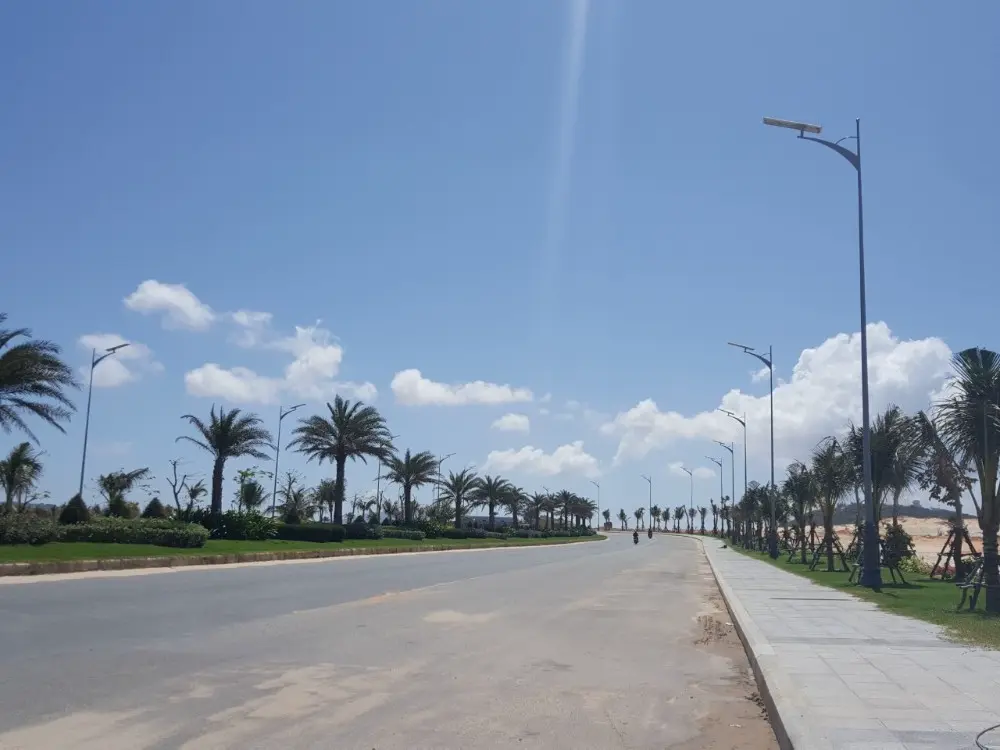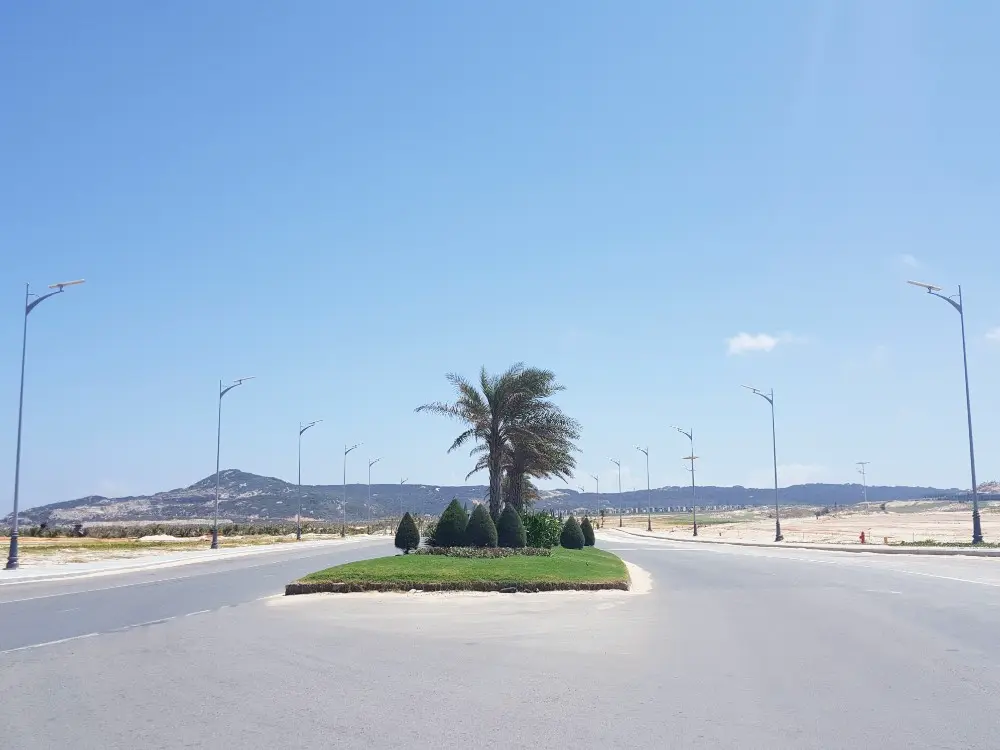Driven by global urbanization and the development of green transportation, solar lighting technology is emerging as an ideal solution for enhancing safety and sustainability on urban highways. As a leading brand in the solar streetlight industry, SRESKY has delivered an efficient and environmentally friendly lighting solution for a highway in a Vietnamese city through its Atlas series of integrated solar streetlights. This project successfully addressed inadequate nighttime lighting, improving driving safety and urban aesthetics while achieving zero-carbon emissions.
I. Project Background and Needs Analysis
1.1 Project Background
The project is located on key highways in a Vietnamese city, which serve as vital arteries for both the local economy and residents’ daily lives, with average daily traffic volumes in the tens of thousands. Certain sections suffered from insufficient nighttime lighting, leading to frequent accidents, particularly during twilight or cloudy weather when visibility is low. According to the Vietnamese Ministry of Transport, inadequate lighting contributes to approximately 35% of nighttime accidents.
Traditional grid-powered lighting solutions require complex infrastructure, with costs exceeding US$150,000 per kilometer, construction periods lasting several months, and ongoing high electricity and maintenance costs, creating a significant financial burden.
Vietnam’s abundant solar resources, averaging over 2,000 hours of sunshine per year, provide ideal conditions for solar lighting. The project client—the Vietnamese Ministry of Transport or municipal management department—aims to enhance road safety and support the national “Green Vietnam” strategy through modern lighting upgrades. With experience in over 3,500 global bidding projects, SRESKY became the preferred partner, providing efficient and cost-effective lighting solutions for urban roads.
1.2 Core Requirements and Challenge Analysis
On-site surveys and data analysis identified four key requirements and challenges commonly encountered in urban highway lighting:
-
High Brightness and Uniformity: Highways require adequate brightness (6,000–10,000 LM) and uniform light distribution across main and auxiliary roads to eliminate blind spots. Type II light distribution meets Vietnam’s standard (illuminance >15 lux).
-
Independent Power Supply Capability: Remote sections make grid connection costly. The lighting system must rely 100% on solar power, with >21% charging efficiency to achieve zero electricity costs and continuous nighttime operation.
-
High Environmental Adaptability: Vietnam has a tropical monsoon climate with temperatures of 28–35°C, humidity above 80%, and annual rainfall up to 2,000 mm. The system must meet IP65 waterproof and dustproof standards, IK08 impact resistance, and withstand heat, humidity, and strong winds, ensuring a lifespan over 5 years.
-
Long-term Economic Benefits: Initial investment and maintenance costs must be minimized. High cost-effectiveness is required, with modular design reducing maintenance complexity and an expected ROI within 3 years.
These requirements reflect the main challenges in urban highway lighting: balancing safety, economy, and environmental protection in high-traffic scenarios. The SRESKY Atlas series aligns perfectly with these needs through its innovative technologies.
II. Technical Solution Design
To meet high urban highway lighting standards, the project implemented a solution based on the SRESKY Atlas series solar streetlights, integrating efficient components and intelligent technologies for excellent performance and long-term reliability.
2.1 Product Selection
The project deployed hundreds of SRESKY Atlas series solar streetlights with configurations tailored to different road sections:
-
Brightness: 6,000–10,000 LM
-
Installation height: 6–10 meters
-
Spacing: 22–32 meters
-
Design: Sleek, integrated, modern, harmonizing with urban aesthetics
Core Components:
-
High-efficiency monocrystalline silicon solar panels: Conversion efficiency >21%, charging time 6.7–10 hours, 20% more efficient than polycrystalline panels.
-
Long-life lithium-ion batteries: Cycle life >1,500 cycles, operating temperatures -20°C to +60°C.
-
High-efficiency LEDs: OSRAM LEDs, 230 lm/W, Type II light distribution for uniform illumination without dark zones.
2.2 Core Technology Highlights
The Atlas series stands out for its patented technology stack addressing urban highway challenges:
-
ALS 2.3 Adaptive Lighting System: Uses intelligent algorithms to monitor battery and lighting history, dynamically adjusting brightness (25%-100%) for continuous operation even during 10 consecutive rainy days. Improves battery life by 30%, ideal for Vietnam’s rainy season (May–October, 2,000 mm rainfall).
-
TCS Intelligent Temperature Control System: Real-time thermal management prevents battery degradation in high temperatures (>35°C), supporting charging at 0–45°C and discharging at -20–60°C.
-
BMS Battery Management System: Optimizes charging, increasing speed by over 30%. LED indicators (red <30%, orange 30–70%, green >70%) enable real-time battery monitoring.
-
High Protection Rating & Modular Design: IP65 waterproof, IK08 impact-resistant, aluminum alloy + PC body, dual anti-corrosion protection. Modular components allow on-pole replacement with low maintenance, operable by a single person in under 20 minutes.
These technologies make the Atlas series suitable for high-demand applications, including urban highways and industrial parks.
III. Project Implementation and Rollout
Project construction was completed within three weeks, minimizing disruption to highway traffic.
3.1 Planning and Design
Installation height and spacing were calculated based on road width (10–20 m), length (~10 km), and traffic flow. Lighting simulations ensured illuminance >15 lux across main and auxiliary roads. Example: SSL-36 for secondary roads (22 m spacing) and SSL-310 for multi-lane main roads (32 m spacing). Streetlights are neatly arranged, following precise planning.
3.2 Equipment Transportation
All streetlights and accessories were packaged with moisture-proof and impact-resistant materials and transported safely via sea and land, achieving zero losses.
3.3 Commissioning and Acceptance
Each streetlight underwent functional testing: holding the power button 1.5 seconds to verify ALS, TCS, and lighting modes. Nighttime brightness tests confirmed illuminance compliance, ensuring 100% coverage.
IV. Project Outcomes and Impact
4.1 Social Value
-
Enhanced Driving Safety: Nighttime visibility improved by 30%, nighttime accident rates decreased by 35%, eliminating blind spots.
-
Improved Urban Image: Modern solar streetlights enhance city aesthetics and modernization perception, receiving positive feedback from residents and tourists.
4.2 Economic and Environmental Benefits
-
Green Goals Achieved: 100% solar operation reduces annual carbon emissions by over 100 tons, supporting Vietnam’s “Green Vietnam” initiative.
-
Economic Benefits: Zero electricity costs save over $300,000 annually. Modular design and a 3-year warranty reduce maintenance costs, with ROI expected within 3 years.
4.3 Technical and Brand Impact
The SRESKY Atlas series provides reliable, cost-effective solutions for urban highways, earning recognition from transportation authorities and establishing a benchmark for green infrastructure in Vietnam.
Summary
The solar lighting project on a Vietnamese city highway demonstrates the outstanding performance of the SRESKY Atlas series on urban main roads. Through efficient deployment, the project improved nighttime safety, enhanced the urban image, and promoted green energy adoption. This case offers valuable experience for global urban transportation upgrades, proving the immense potential of solar lighting in safety, economy, and environmental protection.
For similar projects, visit the SRESKY official website to contact our expert team and illuminate your green future!
Table of Contents

